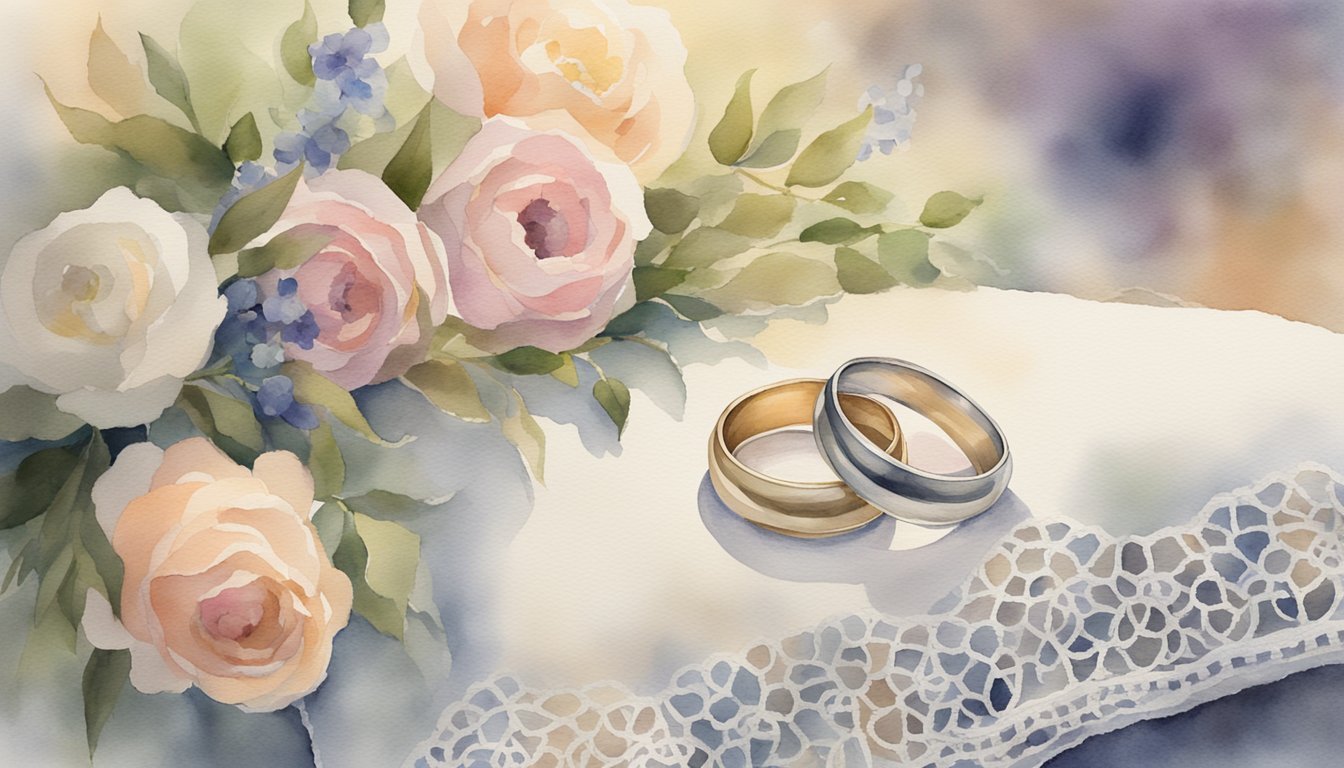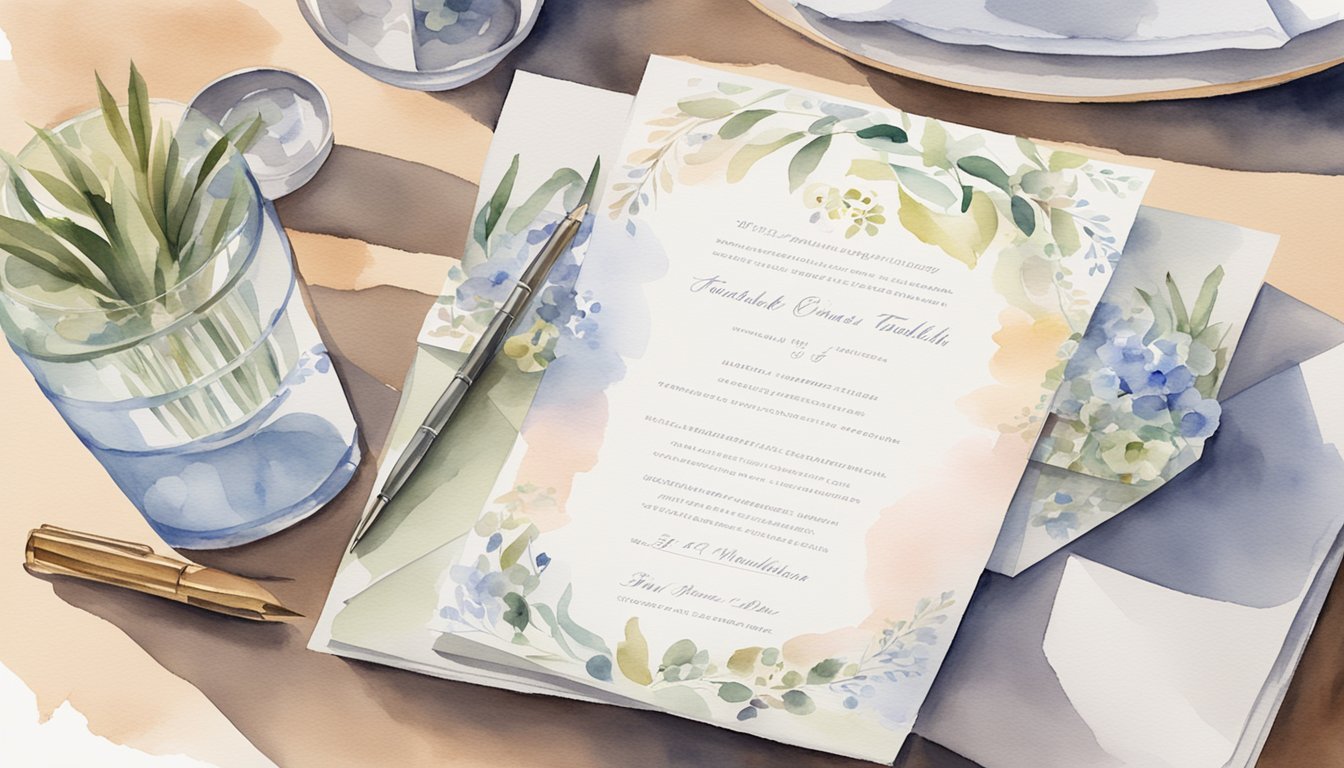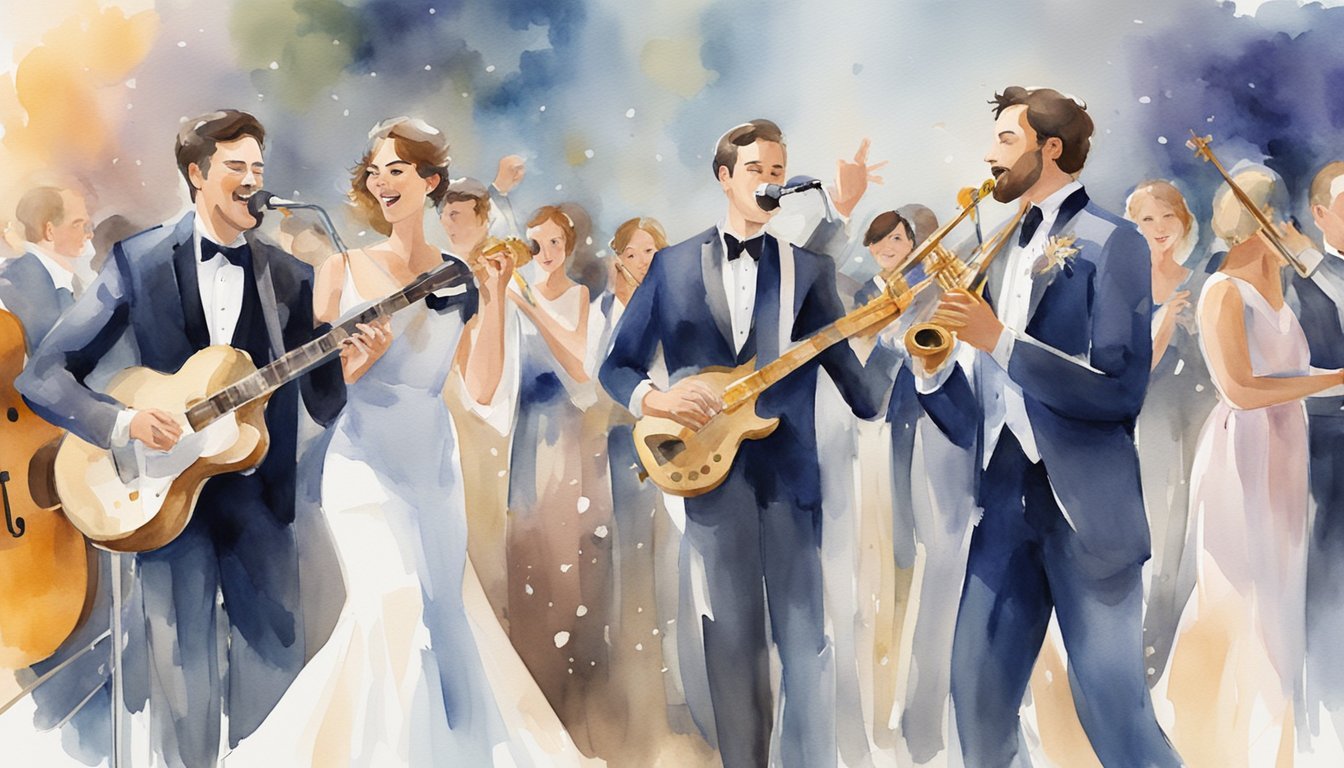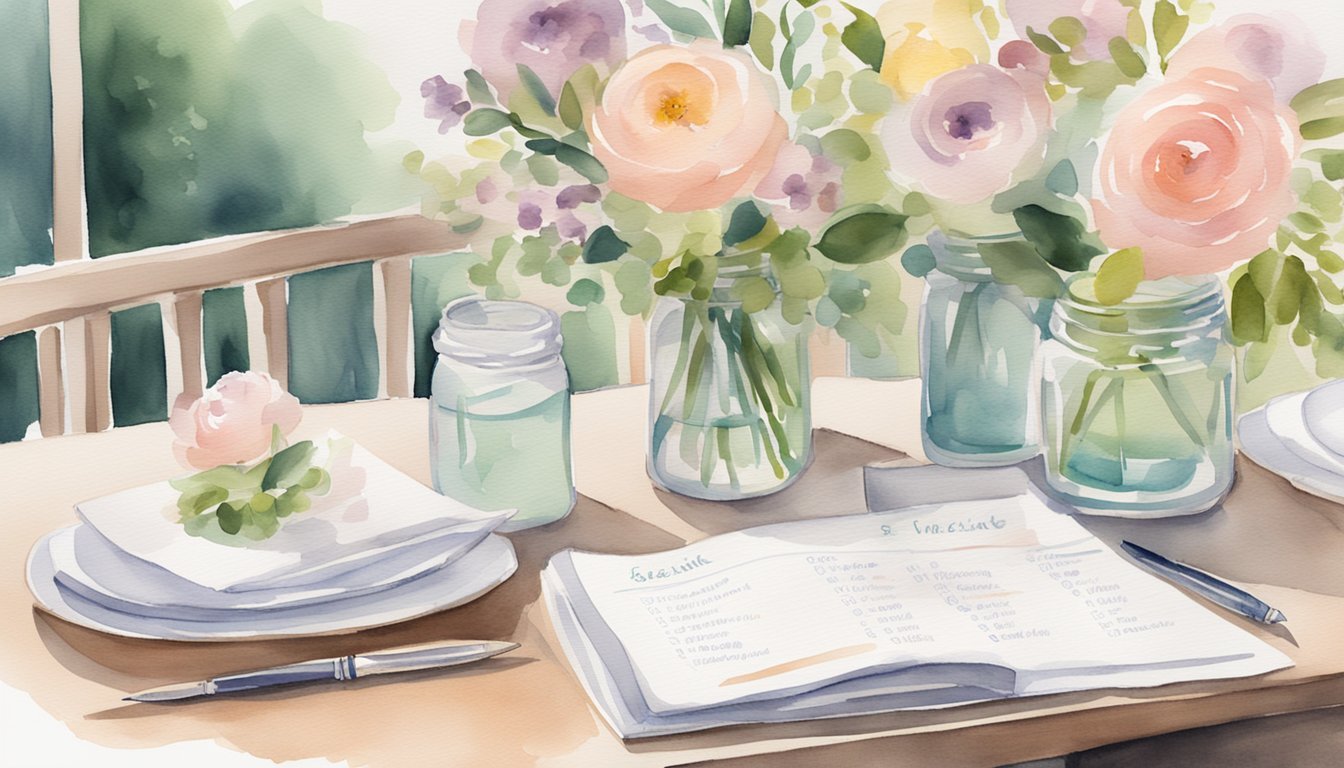Your Ultimate Wedding Checklist: 15 Essentials for a Perfect Day

Planning a wedding can be one of the most exciting yet overwhelming experiences.
With so many details to consider, having a clear and comprehensive checklist is essential to staying organized and ensuring nothing is overlooked. What exactly should you include in your ultimate wedding checklist to make sure your big day goes smoothly?

From booking your venue to organizing your guest list, every step requires attention and care.
This article will guide you through the most important aspects to focus on, so you can create the wedding of your dreams with confidence and ease.
1) Wedding Rings

Selecting your wedding rings is one of the most important tasks.
These rings symbolize your commitment and love.
Start by deciding on the metal.
Gold, white gold, and platinum are popular choices.
Each has its unique qualities and durability.
Consider the style and design.
Do you prefer simple bands, or rings with intricate details? Think about what reflects your personal taste.
Ensure the rings fit comfortably.
You don’t want anything too tight or loose.
It’s a good idea to get professionally sized.
Budget is also important.
Wedding rings come in a wide range of prices.
Decide on a budget that works for you and stick to it.
Think about the future.
Will your rings match other jewelry you wear? Will you want to add stones or engravings?
Check the warranty and insurance options.
These can protect your investment in case of loss or damage.
Finally, order your rings well in advance.
This way, you can handle any adjustments or changes without stress.
For more tips on wedding rings, you can visit an ultimate wedding planning guide.
2) Bridal Gown

Choosing your bridal gown is one of the most important steps in planning your wedding.
Start by exploring different styles and fabrics to find what suits you best.
Consider visiting several bridal shops and trying on a variety of gowns.
Aim to make your selection at least 8-10 months before your wedding day.
This allows enough time for fittings and any necessary alterations.
When choosing your gown, think about the venue, season, and overall theme of your wedding.
Don’t forget to set a budget for your bridal gown and stick to it.
Wedding gowns can vary greatly in price, so having a budget helps you narrow down your options.
Remember to account for additional costs, such as alterations, accessories, and any preservation services you might need after the wedding.
It’s also helpful to bring along a trusted friend or family member when shopping for your gown.
They can offer valuable feedback and support during the decision-making process.
Once you’ve chosen your dress, schedule fittings closer to your wedding date to ensure it fits perfectly.
This is also the time to finalize your accessories, like your veil, jewelry, and shoes, to complete your bridal look.
For more tips on selecting the perfect bridal gown, you can check out this ultimate wedding checklist.
3) Groom’s Attire
Choosing the right attire is crucial for the groom.
Start by deciding on the style.
Options include classic tuxedos, sharp suits, or even casual outfits for a relaxed wedding.
Think about what matches the wedding theme and your personal taste.
Next, consider your budget.
Groom attire can range from a couple hundred dollars to over a thousand.
According to The Knot, the average groom spends between $200 and $499 on the wedding day outfit.
You’ll also need to coordinate with your groomsmen.
Make sure their attire complements yours.
This doesn’t mean everyone needs to match exactly, but the styles and colors should look good together.
Don’t forget the accessories.
Ties, cufflinks, belts, and shoes complete the look.
Make sure these items are chosen well in advance to avoid last-minute issues.
Final fittings are essential.
Schedule these close to the wedding date to ensure the perfect fit.
Nothing should be left to chance with your wedding attire.
Consider renting if you’re on a tight budget or don’t foresee another occasion to wear the outfit.
Places like Men’s Wearhouse and online services can provide stylish options at a fraction of the cost.
Look into buying insurance for your attire if it’s especially pricey.
This can protect against any potential damage or loss leading up to the big day.
Plan ahead and stay organized to ensure you look your best.
For a more detailed guide, visit Groom Wedding Attire 101 on The Knot.
4) Save the Date Cards
Save the date cards are crucial for informing your guests about your wedding date well in advance.
They help your guests plan ahead, especially if they need to travel or take time off work.
Send out your save the date cards about six to eight months before your wedding.
For destination weddings, aim for around eight to twelve months.
Include important details such as your names, the wedding date, and the location.
You don’t need to specify the exact venue yet, a general city or area is enough at this stage.
Design your save the date cards to match your wedding theme.
This gives your guests a sneak peek of what to expect.
If you haven’t finalized your theme, choose a simple and elegant design.
Consider including your wedding website link on the save the date card.
This makes it easy for guests to stay updated on details as you finalize them.
Choose between physical cards and digital save the dates.
Physical cards are traditional and tangible, but digital ones can be more eco-friendly and less expensive.
Order a few extra save the date cards to account for any errors or last-minute additions to your guest list.
Always keep a couple as keepsakes for yourself.
Send the cards to all invited guests, even those you are sure will attend.
It is a courteous way of ensuring that everyone has the same information.
5) Invitations

Sending out wedding invitations is an essential step in your planning process.
Invitations are not just about providing information; they set the tone for your big day.
Your invitation suite should include the main invitation, RSVP card, a return envelope, and any additional information like directions or dress code.
These elements should be consistent in design.
Consider the traditional elements of a wedding invitation suite.
This includes your main invitation, which should detail the names of the couple, the wedding date, time, and location.
The RSVP card will help you keep track of who is attending.
Make sure to set a clear deadline for responses.
If you include a pre-addressed, stamped envelope, it makes it easier for guests to reply.
Adding a personal touch, like custom illustrations or monograms, can make your invitations standout.
You can opt for stationery items like save-the-dates, ceremony programs, and menu cards.
Remember, it’s best to send out your invitations six to eight weeks before the wedding.
This gives your guests ample time to plan and RSVP.
Decide if you want traditional paper invites or digital ones.
Digital invitations are eco-friendly and easier to manage.
However, paper invites have a classic, tangible feel.
Lastly, consult with a calligrapher or use elegant fonts for the envelopes.
The presentation of your invitations is the first impression of your wedding, so make it count.
6) Wedding Cake
Your wedding cake is more than just a dessert; it’s a centerpiece.
First, decide on the cake size.
This depends on your guest count.
Most cakes are priced per slice.
So, having a finalized guest list helps budget correctly.
Choose a design that reflects your wedding’s theme.
Whether it’s a simple three-tier cake or a lavish artistic display, your cake design should match your style.
Flavor is key.
Schedule a tasting appointment with your baker to choose your preferred cake flavors and fillings.
From classic vanilla and chocolate to exotic options, there’s a flavor for every palate.
Don’t forget the cake topper.
It can be traditional or something unique to you as a couple.
This small detail adds a personal touch to your cake.
Think about the cake stand and serving set.
Cake stands, platters, and trays at different heights can add a creative display.
You’ll also need a nice serving set for the cake cutting ceremony.
Consider having favor bags or to-go boxes for leftovers.
This way, your guests can enjoy a piece of your wedding cake even after the event.
Finally, plan for delivery.
Make sure your baker knows the exact location and time for cake delivery to ensure it arrives safely and on time.
For more details, check out this wedding cake checklist.
7) Catering Service
Choosing the right catering service is key to a successful wedding.
You need to start by finalizing your guest count.
Ensure you accommodate dietary restrictions.
This will help plan meals that suit everyone.
Discuss your preferences with the caterer.
Decide if you want a plated lunch or a buffet.
A plated lunch costs around $40 per person, while a buffet is about $27 per person, according to Wedbuddy.
Include beverages in your plan.
Alcoholic and non-alcoholic options are standard.
An open bar averages $15 per person.
Confirm these details with your catering team.
Provide your caterer with place cards, table numbers, and menus.
Give a detailed day-of schedule and floor plan.
This ensures smooth execution on the big day.
Keep in mind that catering managers will need to know arrival and teardown times.
Remember to organize payments.
Prepare tips for your vendors in envelopes.
Communication with your catering service is vital.
Have a final meeting or call to confirm everything.
Lastly, plan for leftovers.
Provide items like aluminum trays and labels so that guests can take food home.
Checklists can help you stay on top of all these tasks.
You’ll want your dining experience to reflect your style and preferences.
Make sure to discuss presentation and food-serving methods.
For instance, chafing dishes are popular for keeping food warm at buffets (UpMenu).
Effective planning can significantly enhance your wedding day.
8) Officiant
An officiant plays a crucial role in your wedding ceremony.
They lead the event, guide you through your vows, and make the marriage official.
Organizing this part early can ensure a smooth ceremony.
First, you’ll need to choose an officiant who fits your style.
This could be a religious leader, a judge, or a friend authorized to perform weddings.
Plan a meeting with your officiant to discuss the ceremony’s format.
This includes the order of events, any readings, and special rituals.
Communication ensures everyone is on the same page.
Confirm the officiant’s arrival time for both the rehearsal and the wedding day.
This helps avoid last-minute issues.
You can also send them a detailed schedule and floor plan to make sure they know where to be and when.
Don’t forget the legal side of things.
Make sure your officiant knows the laws in your state about marriage licenses.
They will need to fill it out with witnesses and make sure it is submitted after the ceremony.
If your ceremony includes special elements, such as religious readings or family comments, inform your officiant well in advance.
They can incorporate these smoothly into the ceremony.
Preparation is key.
By working closely with your officiant, you can ensure that your wedding ceremony is both meaningful and smooth.
For more detailed checklists and timelines, you can refer to resources like Wedding Pioneer.
9) Photographer
Your wedding photographer plays a key role in capturing all the special moments of your big day.
It’s important to choose someone whose style you love and who makes you feel comfortable.
Plan a meeting with the photographer to discuss your vision.
Share examples of photos you like and talk about must-have shots, such as family portraits and candid moments.
Consider creating a detailed shot list.
This can include moments like the bride and groom getting ready, the ceremony venue, and the first kiss.
This ensures that no important moment is missed.
Think about the different parts of your wedding day.
You will want photos of the pre-wedding preparations, the ceremony, and the reception.
Each part offers unique opportunities for beautiful photos.
Discuss the timeline with your photographer.
Make sure they know the schedule of the day, so they can be in the right place at the right time.
This helps in capturing every special moment.
Ask about backup equipment.
Professional photographers should have extra cameras and lenses in case of any technical issues.
This ensures that nothing can go wrong.
Don’t forget to talk about the post-wedding process.
Find out how long it will take to get your edited photos and if they offer any photo albums or prints.
Review their previous work.
Look at complete wedding albums to get a sense of the consistency and quality of their work.
For more ideas on what to include in your photography plan, check out this wedding photography checklist.
It can help you make sure every important detail is captured perfectly.
10) Videographer
Choosing a videographer is key to capturing the moments of your wedding day.
When selecting one, check their portfolio to see if their style matches what you envision for your big day.
It’s also important to read reviews to ensure they’re reliable and professional.
Create a shot list to ensure all important moments are captured.
Key moments to include are the bride getting ready, the exchanging of vows, and the first dance.
Plan time for the videographer to get both candid and posed shots throughout the day.
Discuss your expectations in detail.
Ensure that the videographer knows what you want and any special instructions you may have.
This includes the length of the final video and any specific editing styles you prefer.
Consider the equipment they will use.
Make sure they have high-quality cameras, microphones, and lighting.
Ask if they have backup equipment in case anything goes wrong.
This will ensure that no precious moment is missed.
On the day of the wedding, stay in touch with your videographer.
Make sure they are capturing all the important activities and communicate if any changes occur, such as a shift in the schedule or unexpected events.
Take time to discuss the timeline for receiving the final video.
Confirm how long editing will take and when you can expect to receive your wedding video.
Think about the different options for your wedding video.
Some companies even offer a short highlight reel along with the full-length video.
This can be a great option for sharing memories with friends and family who couldn’t attend.
By effectively planning and communicating with your videographer, you can ensure that every cherished moment of your wedding day is beautifully captured on video.
11) Florist
Choosing the right florist is crucial for making your wedding day beautiful.
You’ll need someone who can bring your vision to life and knows how to work with your selected color scheme and theme.
It’s important to review their portfolio to see if their style matches yours.
Schedule a consultation with your potential florist to discuss your ideas and budget.
During this meeting, you can talk about specific flowers you like and dislike.
Make sure to ask about their availability on your wedding date.
Florists can also suggest seasonal blooms that will be in their prime on your big day.
This can help you save money and ensure the flowers look their best.
Ask if they provide additional services like setup and teardown.
This can save you and your wedding party a lot of stress on the wedding day.
Don’t forget to inquire about the florist’s delivery area.
Some florists may charge extra for long-distance deliveries.
It’s helpful to pick a florist who is familiar with your venue and can coordinate with the on-site staff.
Get everything in writing, including the types of flowers, arrangements, and additional services.
A clear contract helps prevent misunderstandings later on.
Consider florists who have good reviews and recommendations.
Personal experiences from past clients are often very telling.
Lastly, plan to order your flowers about six months before the wedding.
This gives the florist enough time to source the blooms and plan the arrangements.
For more detailed advice, you can check out this wedding flowers checklist.
12) Music Band

Choosing a music band for your wedding can set the tone for the entire event.
A live band adds energy and excitement, creating unique moments for you and your guests.
You’ll need to decide on the type of music you want.
Do you prefer jazz, rock, pop, or classical? Make sure the band can play your favorite songs and cater to a variety of musical tastes.
For the cocktail hour, a playlist of around fifteen songs is commonly adequate.
These should be light and lively to keep your guests entertained.
Don’t forget the key moments of your wedding.
The bridal entrance, first dance, and cake cutting each need their own special songs.
The band should be prepared to play these at the right times.
Think about the size of the band as well.
A full band with multiple instruments can deliver a powerful performance.
If your venue is smaller, a trio or quartet might be more appropriate.
Make sure to check the band’s reviews and ask for a live demo.
This will help you see if their style matches what you’re looking for.
Clear communication with the band is essential, so they understand your expectations.
Discuss the logistics with the band, including setup, breaks, and the overall timeline.
Knowing how they operate will ensure smooth transitions throughout your event.
13) DJ for Reception

A good DJ brings energy and flow to your wedding reception.
They play music that keeps guests entertained and excited.
You should start by choosing a DJ with experience and good reviews.
Check their availability and make sure they fit your budget.
Discuss with your DJ which songs are must-plays.
This includes your first dance, father-daughter dance, and mother-son dance songs.
Consider your guests’ preferences too.
Provide the DJ with a list of songs you like and those you don’t.
Ensure your DJ has the necessary equipment.
This includes speakers, microphones, and a laptop for playing music.
Some DJs offer lighting and special effects as well.
Plan out the timeline for music.
Include cocktail hour, dinner music, and dance floor opening.
A professional DJ can handle announcements too.
They can introduce the wedding party, lead the bouquet toss, and announce the cake cutting.
Choose a DJ who can read the room.
They should know when to keep the energy high and when to slow things down.
Prepare a list of backup songs.
This helps if the original choice doesn’t go well with the guests.
Meet with the DJ a few weeks before the wedding.
Go over the timeline, song list, and any special requests.
Having a professional DJ ensures a seamless flow of events.
A DJ sets the tone and keeps the party going all night.
For more details, check out this DJ wedding checklist.
14) Wedding Favors
Wedding favors are a great way to thank your guests for coming.
They add a personal touch to your celebration and give your guests something to remember the day by.
Personalized items are always popular.
You could give your guests something useful, like a custom champagne flute with your names and wedding date, as seen on The Knot.
These can double as part of the table settings.
Edible treats are another good choice.
Heart-shaped tea bags, small jars of honey, or local jams can be tasty and thoughtful.
They show that you’ve put some thought into your guests’ enjoyment.
Handmade gifts are also meaningful.
Consider something you or a loved one has made. Candles, soaps, or small crafts can be a lovely, unique touch that shows care and effort.
If you want to go green, think about eco-friendly favors.
Seed packets, reusable straws, or bamboo cutlery sets are not only thoughtful but also good for the environment.
Remember to match the favors to the theme of your wedding.
If you’re having a beach wedding, you could give out mini bottles of sand from the venue or seashell keychains.
For a rustic wedding, consider mason jar favors or small potted plants.
Make sure to present your wedding favors nicely.
Cute packaging can make even a simple gift look special.
Small boxes, bags, or ribbons can add the perfect finishing touch.
By choosing the right wedding favors, you give your guests a little piece of your special day to take home.
This small gesture can leave a lasting impression and show your gratitude for their presence on one of the most important days of your life.
15) Transportation
Transportation is a key part of wedding planning.
You need to arrange rides for the wedding party and guests.
This includes deciding on pickup and drop-off points and times for everyone.
Rental companies usually charge by the hour and have a minimum time, often three hours.
You should plan the duration from the pickup time to the end of the reception.
This helps you figure out if it’s worth having the wheels wait.
Make sure to get an approximate number of people needing rides from each location.
Giving the transportation company a day-of contact, such as your planner or personal attendant, is crucial.
They will handle any issues that come up.
Confirm all details close to the wedding day.
Double-check pickup and drop-off times, locations, and routes.
Send a day-of schedule and map to the drivers to avoid any confusion.
Don’t forget to include tips for your drivers.
Typically, a 15% to 20% tip is part of the contract.
If not, giving $20 per driver is a good standard.
Consider having emergency kits in the transport vehicles.
These kits can have items like safety pins, double-sided sticky tape, band-aids, and aspirin.
Such items can save the day if something goes wrong.
Don’t overlook refreshments.
Having drinks and snacks in the vehicle can make the ride more comfortable.
Make sure to pack glasses or drinkware if needed.
Booking wedding day transportation may seem small, but it plays a big role in keeping the day smooth and enjoyable.
Budget Planning

Effective budget planning for your wedding includes allocating funds wisely and keeping track of all expenses.
This ensures that every detail is covered, and there are no financial surprises.
Allocating Funds
When you start planning, the first step is to set a realistic budget.
Discuss with your partner and families what a comfortable amount to spend is.
List all possible expenses and allocate a percentage of your budget to each category.
For example, you might spend 15% on photography and videography, 10% on flowers, and 10% on music and entertainment.
Tools like the Excel Wedding Budget Spreadsheet can be very helpful in managing this.
Also, set aside a small reserve fund for unexpected costs.
Here’s a simple example of how you might allocate your funds:
| Category | Percentage of Budget |
|---|---|
| Venue and Catering | 40% |
| Photography/Videography | 15% |
| Music/Entertainment | 10% |
| Flowers | 10% |
| Wedding Attire and Beauty | 5% |
| Miscellaneous | 5% |
| Reserve Fund | 15% |
Remember to adjust these percentages to match your priorities.
If you place higher importance on any specific category, allocate more funds to it accordingly.
Tracking Expenses
Keeping track of your wedding expenses is crucial for staying within your budget.
Use digital tools or apps to monitor your spending.
You can use a wedding budget tool to trace every payment made.
This helps you see where your money is going and allows you to adjust as needed.
Make a habit of recording each transaction as soon as it happens.
Keep all receipts and contracts in one place.
Every month, review your spending to ensure you are on track.
Consider creating a checklist of due dates for payments like deposits for the venue or final balances for vendors.
Detailed tracking helps you avoid overspending and makes it easier to allocate remaining funds efficiently.
By staying organized and diligent, you can manage your wedding expenses effectively and enjoy a stress-free planning process.
Venue Selection
Choosing the right venue is essential for a successful wedding.
Focus on whether you want an indoor or outdoor setting, the number of guests, and logistics like parking and accessibility.
Indoor Versus Outdoor
Deciding between an indoor and outdoor venue is one of the first steps. Indoor venues offer more control over the environment.
You don’t need to worry about weather, and you can typically take advantage of built-in amenities like air conditioning, restrooms, and lighting.
Outdoor venues offer natural beauty and unique settings.
Consider the weather and time of year.
Renting tents, portable restrooms, and sound systems might be necessary.
Check if the outdoor space has backup options for bad weather, such as an indoor hall or pavilion.
Think about your personal style and the theme of the wedding.
An indoor venue might be perfect for a classic or traditional theme, while an outdoor venue might suit a rustic or bohemian vibe better.
Guest Capacity
The number of guests will significantly impact your venue choice.
Start with an estimated guest list. Large venues can accommodate hundreds of guests comfortably, but they may feel too spacious if your guest list is small.
Verify if the venue has size limitations or minimum guest requirements.
Smaller venues create a more intimate atmosphere.
They can still host all the traditional wedding activities but on a smaller scale.
Ensure that there is enough space for dining, dancing, and other activities.
Consider your budget too.
More guests mean more costs, not just for seating but also for food, drinks, and service.
Many venues offer packages based on guest count, which can simplify your planning and help manage costs.
Logistics and Accessibility
Logistics include the practical aspects of getting to and enjoying your venue.
Check the accessibility for all your guests, including those with disabilities.
Is there ample parking, and is it close to the venue entrance? Are there ramps or elevators?
Evaluate the venue’s location relative to accommodation for out-of-town guests.
Provide transportation options if needed, such as shuttle services or clear directions for ride-sharing.
Think about the layout for the ceremony, cocktail hour, and reception.
This may involve multiple spaces within the venue.
Clear signage and a logical flow can make a big difference.
Confirm that all vendors have easy access for setting up their services, such as catering, florists, and musicians.
Using this checklist will help ensure you select a venue that meets all your needs, creating a seamless and enjoyable experience for everyone.
Vendor Coordination

Coordinating wedding vendors involves selecting reliable vendors who meet your vision and carefully reviewing contracts to ensure all terms and conditions are clear.
Selecting Reliable Vendors
Finding the right vendors can make or break your wedding day.
Start by researching different vendors for each service you need, such as catering, photography, and entertainment.
Look at reviews on websites and ask for recommendations from friends or family.
When you have a list of potential vendors, schedule interviews or meetings to discuss your ideas and see if they align with your vision.
It’s important to ask questions about their experience, availability, and types of services they offer.
Check their portfolios to see examples of their work.
It’s also useful to ask for references from past clients to ensure they are professional and reliable.
Making an informed decision early will save you a lot of stress later on.
Contract Review
Once you’ve chosen your vendors, the next step is to carefully review the contracts.
Ensure the contract includes all the details you discussed, such as dates, times, services provided, and payment schedules.
Pay close attention to the cancellation and refund policies.
It’s important to know what happens if the vendor can’t provide the service on your wedding day or if you need to cancel their services.
It’s advisable to have a second pair of eyes, like a lawyer or experienced friend, review the contract.
This will help catch any potential issues you might miss.
Always make sure you understand every part of the agreement before signing to avoid any surprises.

